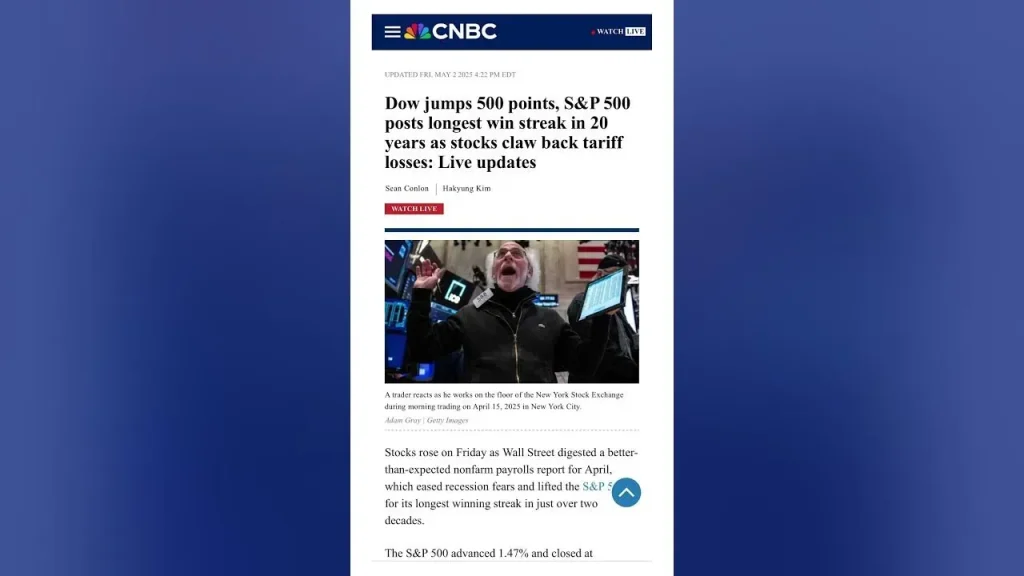In a remarkable turn of events, the Dow jumps 500 points, showcasing a robust rebound in the stock market as investors respond positively to a better-than-expected nonfarm payrolls report for April. This uplifting news has not only eased recession fears but also contributed to the S&P 500 achieving its longest win streak in over 20 years, a testament to market resilience amidst tariff uncertainties. The stock market news has significantly shifted sentiment, indicating a recovery from the previous downturn linked to tariff effects on stocks. As discussions around trade negotiations between the U.S. and China unfold, market analysts remain optimistic that the easing of economic pressures may support continued growth. Investors are closely monitoring these developments, while the potential lifting of tariffs could further bolster market gains in the weeks to come.
In a striking market development, the Dow has surged over 500 points in response to positive economic indicators, particularly the nonfarm payrolls report that exceeded forecasts. This surge not only marks a significant recovery path for the stock indices but also highlights the ongoing streak of gains in the S&P 500, a leading benchmark in the financial landscape. Amid speculation around the impacts of tariffs on various sectors, traders are assessing how new trade discussions between the U.S. and China could influence future market dynamics. As confidence builds within the investment community, the atmosphere is cautiously optimistic, suggesting a potential end to recent market turmoil attributed to trade tensions. This upbeat market sentiment may pave the way for sustained upward momentum in light of encouraging economic signals.
Dow Jumps 500 Points: A Significant Market Rally
On Friday, the financial world witnessed a significant upswing as the Dow Jones Industrial Average soared by 564.47 points, marking a remarkable recovery and ending the day at 41,317.43. This surge can be attributed to the better-than-expected nonfarm payrolls report, which calmed investors’ recession fears that had been prominent in the previous weeks. The 1.39% increase in the Dow is a testament to the resilience of the stock market in the face of challenges, particularly related to tariffs and trade negotiations.
This positive momentum in the market not only reflects investor confidence but is also a hopeful sign for the economy as a whole. With the S&P 500 also experiencing its longest win streak in over 20 years, this rally underscores the interconnected nature of economic reports and market performance. Analysts believe that the combination of strong employment data and ongoing discussions about easing tariffs between the U.S. and China played a crucial role in this bullish trend.
S&P 500’s Longest Win Streak in Two Decades
The S&P 500’s recent performance has captured the attention of market analysts, achieving its longest win streak since 2004. This streak reflects a robust recovery from previous lows, largely driven by strong economic indicators such as the nonfarm payrolls report for April. With the S&P closing at 5,686.67 after advancing 1.47%, investors are buoyed by the collective optimism surrounding the index’s ability to rebound sustainably, highlighted by consistent gains over nine consecutive days.
The gains in the S&P 500 can be attributed to strategic investor behavior in response to favorable economic news, including a surge in job creation. This data outperformed forecasts, which in turn mitigated fears regarding a potential recession. Moreover, the index’s recovery from tariff-related losses emphasizes the market’s sensitivity to economic policies and trade negotiations, particularly between the U.S. and China.
The Role of Tariffs in the Stock Market Recovery
Tariffs have played a critical role in shaping the current landscape of the stock market, particularly as they relate to President Trump’s recent announcements. The market’s recovery has been fueled by a temporary pause in new tariffs for most countries to 10%, which has provided investors with a clearer view of potential earnings. Despite this, concerns linger about the long-term effects of these tariffs on specific sectors, especially technology and consumer goods, where companies like Apple are already bracing for added costs.
The recent rally in stock prices, including the impressive gains in the Dow and S&P 500, can be attributed to the pervasive belief that continued negotiations with China could alleviate some of the pressure that tariffs have created. Analysts contend that while the current market sentiment is cautiously optimistic, it will be crucial to monitor how tax and tariff discussions unfold as they continue to impact overall market stability.
Nonfarm Payrolls Report: What It Means for Investors
The nonfarm payrolls report released for April has provided a much-needed boost to investor confidence, indicating a growth of 177,000 jobs—significantly surpassing the 133,000 forecasted. This positive data has alleviated some recession fears that had been mounting within the investment community. The unemployment rate remaining steady at 4.2% reinforces the stability of the labor market, which is a key driver for economic growth.
Investors are closely watching these employment figures as they gauge the overall health of the economy. A strong jobs report not only influences market sentiment but also impacts Federal Reserve policies regarding interest rates. Positive job growth suggests that consumer spending may remain robust, consequently supporting corporate earnings and overall stock performance in the upcoming quarters.
Trade Negotiations with China: Market Implications
The ongoing trade negotiations between the U.S. and China have increasingly become a focal point for investors, especially with the potential for reduced tariffs on a range of goods. As announcements surface regarding the possibility of renewed discussions, the stock market has responded favorably, reflected in the gains across major indices. The anticipation that resolution may lead to a more stable trading environment has injected optimism into market sentiment.
However, it is important to recognize that the path to a trade agreement is fraught with complexities, and as both nations continue to engage in dialogue, investors remain vigilant. The removal of unilateral tariffs has been positioned as a critical stance for China, suggesting that any resolution will require significant concessions. Thus, market movements may become increasingly reactive to news regarding these discussions in the coming weeks.
Market Outlook: Analyzing Recent Trends
The recent upward trends in stock markets signal a recovery phase, lifting investor sentiment after a challenging period exacerbated by tariff announcements. The S&P 500’s resurgence, alongside other indices, illustrates how quickly markets can respond to both economic data and policy changes. Analysts are optimistic but advise caution, as the S&P approaches resistance levels, suggesting investors should remain alert for signs of volatility.
As analysts project targets and potential profits, they highlight the importance of ongoing economic indicators, including future employment data and corporate earnings reports. The soaring Dow and the S&P’s winning streak are positive, but with recession concerns looming and company forecasts showing mixed signals, a balanced approach to investment strategies is essential for navigating this fluctuating environment.
Sector Performance: Who Are the Winners and Losers?
As the stock market shows strong performances overall, sector-specific dynamics remain varied in response to recent economic developments. Technology stocks, which have been significant drivers of the market rally, find themselves in a nuanced position following mixed earnings reports. For instance, Apple’s share price took a hit due to disappointing revenues, while companies like Amazon also cited tariff implications in their forecasts, demonstrating the complex interplay between sector performance and macroeconomic factors.
Conversely, sectors such as energy and materials may also experience evolving dynamics as crude oil prices fluctuate and OPEC+ discussions on output come into play. Investors are keen on tracking how these sector shifts may influence broader market trends, especially as discussions around tariffs and trade continue to shape industries’ profitability and growth potential.
Psychological Impact of Positive Economic Reports
Psychological factors play a crucial role in stock market behavior, especially when positive economic reports emerge like the recent nonfarm payrolls data. Investor sentiment can dramatically shift with such news, often leading to increased buying activity that supports upward movement in stock prices. This psychological aspect is pertinent in understanding why the market has reacted so favorably to an otherwise average job growth statistic.
Furthermore, the ‘fear of missing out’ (FOMO) phenomenon can amplify market trends, as investors rush to capitalize on perceived opportunities amid positive news cycles. The longer the S&P continues its upward trajectory, the more momentum it builds, influencing even cautious investors to participate in the rally. Consequently, sentiment-driven fluctuations might add further complexity to the market’s behavior as it interacts with fundamental economic indicators.
Investor Strategies Amidst Market Changes
In light of the recent market gains, investors are reassessing their strategies to better navigate the landscape shaped by tariffs and trade negotiations. The resurgence of the Dow and S&P 500 offers a backdrop against which many look at diversification and sector rotation as strategies to mitigate risks. Asset allocation appears crucial as uncertainties linger, and smart investors are likely focusing on industries that show resilience in the face of potential economic shifts.
Adapting to evolving conditions means accounting for both macroeconomic and geopolitical factors that weigh on market performance. Investors may need to develop adaptive strategies that allow for flexibility in their portfolios while remaining poised to capitalize on opportunities presented by ongoing earnings reports and external economic indicators.
Frequently Asked Questions
What caused the Dow to jump 500 points recently?
The Dow jumped 500 points largely due to a better-than-expected nonfarm payrolls report for April, which eased recession fears and boosted investor optimism. This surge in the stock market was part of a broader rally, where the S&P 500 posted its longest win streak in 20 years.
How did the S&P 500 achieve its longest win streak in 20 years?
The S&P 500 achieved its longest winning streak in 20 years by rallying 1.47% after positive job data showed significant payroll growth, further aided by easing concerns over tariffs from trade negotiations between the US and China.
What are the implications of tariff effects on stocks following the Dow’s rise?
The recent rise in the Dow reflects the market’s recovery from initial tariff-induced losses as recent trade negotiations have suggested a possible easing of tariffs, contributing positively to the stock market performance.
How does the nonfarm payrolls report influence stock market trends?
The nonfarm payrolls report significantly influences stock market trends by providing insights into employment growth, which affects economic confidence and investor sentiment. A stronger-than-expected report, as seen recently, often leads to stock market rallies like the recent Dow jump.
What role do trade negotiations between the US and China play in market performance?
Trade negotiations between the US and China play a crucial role in market performance as they impact tariff policies and economic stability. Optimism around potential resolutions can lead to significant stock market gains, contributing to movements like the Dow jumping 500 points.
What should investors consider about the stock market’s response to economic indicators?
Investors should consider that stock market responses, such as the recent rise in the Dow, are often reactions to key economic indicators like nonfarm payrolls and trade policies. Positive reports can lift markets, while concerns about tariffs and recession can lead to volatility.
Are the positive trends in the stock market sustainable despite recession fears?
While the recent trends in the stock market, including the Dow’s rise, show a positive outlook, the sustainability of these gains remains uncertain due to ongoing recession fears and potential new tariff impacts from trade negotiations.
How do analysts view the market’s recovery in relation to tariffs and trade policies?
Analysts view the market’s recovery, including the Dow’s 500-point jump, with cautious optimism, noting that while current trends are positive, the long-term impact of tariffs and trade policies poses ongoing risks that could affect future performance.
What factors are contributing to the market’s positive sentiment despite tariff concerns?
Factors contributing to the market’s positive sentiment include strong economic indicators like the nonfarm payrolls report, investor optimism surrounding trade negotiations with China, and the recent lifting of certain tariffs, all of which support the recent rise in the Dow.
What should we expect from the stock market in light of upcoming Federal Reserve meetings?
In light of upcoming Federal Reserve meetings, investors should watch for any signals regarding interest rate adjustments and policy changes, as these could dramatically influence stock market movements following positive trends like the Dow’s recent 500-point jump.
| Index | Points Change | Percentage Change | Closing Value | Duration of Winning Streak |
|---|---|---|---|---|
| Dow Jones Industrial Average | +564.47 | +1.39% | 41,317.43 | |
| S&P 500 | +82.66 | +1.47% | 5,686.67 | 9 consecutive days |
| Nasdaq Composite | +267.74 | +1.51% | 17,977.73 | |
| Nonfarm Payrolls | +177,000 |
Summary
The news that the Dow jumps 500 points highlights a significant recovery in the stock market, thanks to robust employment data and renewed optimism surrounding U.S.-China trade relations. As the S&P 500 experiences its longest winning streak in two decades, fueled by a drop in recession fears and a positive nonfarm payrolls report, investors are cautiously optimistic. While the long-term economic outlook raises concerns, the latest gains suggest a potentially stabilizing market as companies report strength despite external pressures such as tariffs.



